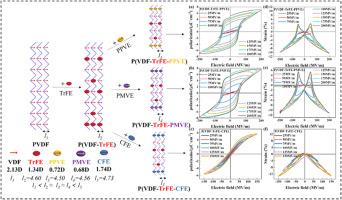The influence of PPVE/PMVE/CFE monomers insertion on the ferroelectric behavior of the P(VDF-TrFE)-based electroactive terpolymers
IF 4.1
2区 化学
Q2 POLYMER SCIENCE
引用次数: 0
Abstract
The perfluoroalkyl ethylene ether (PMVE), perfluoro propoxyethylene (PPVE), and chlorofluoroethylene (CFE) (<4 mol%) as the third monomers are embed into the ferroelectric polyvinylidene-trifluoroethylene (P(VDF-TrFE)), respectively, aiming to modify the ferroelectric behaviors of the copolymers. Through calculation, we find the PPVE and PMVE molecular segments possess a large free volume but a low polarity, effective promoting the formation of all-trans β phase in the crystal region of P(VDF-TrFE), and contributing to the high maximum and remnant polarization (Ps and Pr) of related P(VDF-TrFE-PPVE) (∼6.8 and 6.3 μC cm−2) and P(VDF-TrFE-PMVE) (∼5.6 and 5.0 μC cm−2) under 200 MV m−1, respectively. Differently, the CFE segment provides not only a large volume but also a high polarity, resulting in the phase transition from β to α and thus, the target terpolymer P(VDF-TrFE-CFE) appears a transition from ferroelectrics to relaxor ferroelectrics, and shows a high dielectric permittivity (εr∼55.4) at 100Hz. This work may provide a comprehensive insight of modifying the structures of P(VDF-TrFE), offering crucial guidance for optimizing the design of this type ferroelectric materials.


PPVE/PMVE/CFE单体插入对P(VDF-TrFE)基电活性三元聚合物铁电行为的影响
将全氟烷基乙烯醚(PMVE)、全氟丙烯乙烯(PPVE)和氯氟乙烯(CFE) (<4 mol%)作为第三单体分别嵌入到铁电性聚偏乙烯-三氟乙烯(P(VDF-TrFE))中,旨在改变共聚物的铁电行为。通过计算,我们发现PPVE和PMVE分子片段具有较大的自由体积和较低的极性,有效地促进了P(VDF-TrFE)晶体区域全反式β相的形成,并有助于相关P(VDF-TrFE-PPVE)(~ 6.3和6.8 μC·cm-2)和P(VDF-TrFE-PMVE)(~ 5.0和5.6 μC·cm-2)在200 MV·m-1下的最大极化和剩余极化(Ps和Pr)。不同的是,CFE段不仅体积大,而且极性高,导致从β到α的相变,从而使目标共聚物P(VDF-TrFE-CFE)呈现从铁电体到弛豫铁电体的转变,并在100Hz时表现出高介电常数(εr ~ 55.4)。这项工作可以全面了解P(VDF-TrFE)结构的修饰,为该类铁电材料的优化设计提供重要的指导。
本文章由计算机程序翻译,如有差异,请以英文原文为准。
求助全文
约1分钟内获得全文
求助全文
来源期刊

Polymer
化学-高分子科学
CiteScore
7.90
自引率
8.70%
发文量
959
审稿时长
32 days
期刊介绍:
Polymer is an interdisciplinary journal dedicated to publishing innovative and significant advances in Polymer Physics, Chemistry and Technology. We welcome submissions on polymer hybrids, nanocomposites, characterisation and self-assembly. Polymer also publishes work on the technological application of polymers in energy and optoelectronics.
The main scope is covered but not limited to the following core areas:
Polymer Materials
Nanocomposites and hybrid nanomaterials
Polymer blends, films, fibres, networks and porous materials
Physical Characterization
Characterisation, modelling and simulation* of molecular and materials properties in bulk, solution, and thin films
Polymer Engineering
Advanced multiscale processing methods
Polymer Synthesis, Modification and Self-assembly
Including designer polymer architectures, mechanisms and kinetics, and supramolecular polymerization
Technological Applications
Polymers for energy generation and storage
Polymer membranes for separation technology
Polymers for opto- and microelectronics.
 求助内容:
求助内容: 应助结果提醒方式:
应助结果提醒方式:


